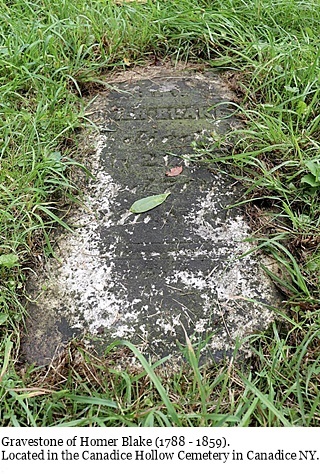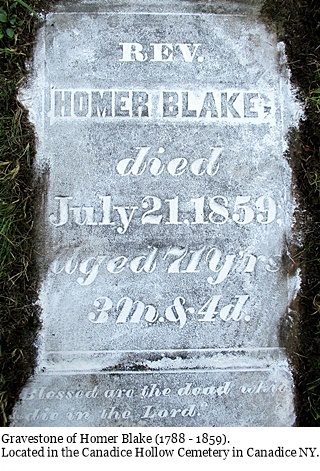
Welcome to Hemlock and Canadice Lakes!
Barns Businesses Cemeteries Churches Clinton & Sullivan Columns Communities Documents Events Time Line Fairs & Festivals Farm & Garden Hiking Homesteads Lake Cottages Lake Scenes Landscapes Library News Articles Old Maps Old Roads & Bridges Organizations People Photo Gallery Podcasts Railroad Reservoir Schools State Forest Veterans Videos
|
Biography of Homer Blake |
Click any image to enlarge. |
|
The Search for Reverend Homer Blake Compiled by David Pierce and featured in Owl Light News. Background - David Pierce and his wife Colleen moved to the Finger Lakes Region earlier this year from the Greater Rochester area to pursue a simpler and more fulfilling lifestyle. David has enjoyed exploring his family history for many years, documenting people, places and events as far back as 1590. He is a certified member of the General Society of Mayflower Descendants, having documented his ancestry back 10 generations to Francis Cooke and Peter Browne, two of the original passengers on the Mayflower voyage of 1620, 400 years ago. Many of his ancestors lived in and around Ontario County for well over 200 years, providing a convenient backdrop for his research. Motivation - Inevitably, the day to day lives of our ancestors fade over time along with the cemeteries and gravestones that mark their final resting places. Older burial grounds become neglected, forgotten and many, for better or worse, fall into ruin; some disappear forever. Sharing New York’s buried past helps preserve the rich histories of brave men and women who have gone before us. Lives of great expectation, long lives and short lives, lives of joy and sorrow, lives of triumph and tragedy, lives of gain and loss ... are all shared and preserved when descendants honor their ancestors through recognition, research and reverence. At the Cemetery - On a hot and humid afternoon in mid-August 2020, my exploration brought me to Canadice Hollow Cemetery, located in the northwest corner of the Town of Canadice, N.Y. on Canadice Hollow Road. This was a lightly traveled remote road through beautiful, green and heavily forested landscapes. The cemetery sits on a knoll, elevated above the street level. If not for the well-maintained sign in front of the knoll, a traveler down the road would pass the site unaware of the rich history contained within its borders. A rutted and shady dirt roadway leads up the grade and travels around the deepest area of the cemetery. Time has not been kind to this Cemetery. The legible gravestones indicate that there has not been a burial there in over 80 years. Although the area is periodically mowed, encroaching vegetation, including poison ivy, is consuming the edges of the burial plots. Toppled, damaged and illegible gravestones are numerous. Nature is well on its way to reclaiming this reverent space, as the people and their lives fade into oblivion. The last restoration project I am aware of was in 2002, when a girl scout made some improvements as part of her Girl Scout gold award. Continuation of restoration efforts would be a wonderful contribution to the local history of Canadice. |
||
|
|
||
|
One of the damaged and toppled stones sits on or near the burial site of my third-great-grandfather the Reverend Homer Blake. His life is the subject of my first exploration of New York’s buried past. Once a prominent, well engraved upright stone, his gravestone was lying face up, flat on the ground when I found it. The stone was nearly covered with dirt and creeping grass and was illegible. There was a jagged break at the bottom, as if the stone had been kicked over, struck by a piece of machinery, or hit by a fallen branch in a windstorm. Armed with my garden tools, I began the task of clearing away the overgrowth, unearthing the stone, and revealing the historical information engraved thereon. Most people do not focus on the reality that we all have thirty-two unique individuals as third-great-grandparents. I personally find enjoyment in naming and discovering each one of mine. Homer Blake was born April 13, 1788 in the town of Nassau, Rensselaer County NY, southeast of Albany, NY. In April of 1847, in his quest to be remembered, Homer recorded information on his life, family and aspirations in a handwritten document. A copy of this document was obtained from the Town of Canadice historical archives. This is a transcription of Homer Blake’s written words: Homer Blake Canadice April 1847 “Homer Blake was born April the 13th, 1788 in the Town of Nassau County of Renseler {sic} State of NY. The said Homer was the son of Frelove {sic}. Frelove {sic} Blake which was the son of Joseph Blake and the said Joseph died in the old French War when on his way from Montreall {sic} in Canada where he had been as a soldier in the Provincial Army and the brothers of Freelove were Seth and Joseph and Richard all of which were born in the State of Connecticut; and they were originally of Scotch decent {sic}; and the Mother of Homer Blake was Lois Spencer daughter of Samuel Spencer anciently of Norman decent {sic} and the said Lois was a native of East Haddam, Connecticut and a woman with excellent disposition. nb the said Freelove as was a soldier in the Revilutionary {sic} War and was in the great Battle of Stilwater {sic} County of Saritoga {sic}, but inasmuch as my forefathers are all gone to the Eternal Worlds and I am hastening to follow them, I wish to leave these lines for my Dear Children to look at when I am gone and sinserely {sic} hope that we may all glorify God Our Savior.” Homer Blake By the early 1800’s, Homer Blake traveled from the Town of Nassau, NY to Onondaga County, NY. He was baptized as an adult at the United Church of Onondaga Hollow and Salina, NY June 5, 1808 and was recognized as a church member in 1810. He married his wife Abigail Coates about 1808. For reasons unknown, he was dismissed from the church on February 19, 1815. The History of Canadice Chronicle provides information about Homer’s life path, back and forth between Manlius, Onondaga County and the lands south of Canadice Lake. In 1811, Homer sought out a place where he intended, in the Spring following, to erect a house and make it a permanent residence. He chopped a small patch and made the legal number of brush heaps, but, as Spring arrived, he became homesick and returned to Manlius. After Homer left, John Edgett, a young man from Richmond, came upon the cleared patch. He added to Homer’s brush heaps and built a single shanty. The shanty was sold to Harry Jones of Richmond for $12.00 in 1813. Harry cleared near all the land and built a log cabin and a barn. Both Homer Blake and his brother Hector were recorded as insolvent debtors in 1820, one year after the NY legislature abolished debtors’ prison. Convenient timing perhaps, but certainly a testament to the difficulty of life for people of the early nineteenth century trying to build their lives. This hardship was quite possibly the catalyst that led Homer Blake to the ministry. When Homer returned from Manlius in 1838, he sought out the property described as “the object of his first love” and made it his permanent and final home. Homer was a Protestant Methodist exhorter, the lowest level of credentialed ministers, for many years. The Methodist Church keeps track of its ordained ministers, but they have no records of the exhorters. Family recollections indicate that one place he preached was in the schoolhouse by the Park in Naples, N.Y. The building was a gift shop at one time and now appears to be a personal residence. Homer’s nephew, Alexander Freelove Blake writes of Homer: “He was a preacher by profession and a man who took an earnest interest in the well-being and betterment of his fellow beings. Homer Blake when first known to his nephew, writer of this statement, was a man of family, a minister of the Gospel and then residing in the Township of Cicero, Onondaga County, NY which must have been as early as 1825 or 30; that the last personal knowledge of him was in the Spring of 1841, after Uncle Homer had moved west to Canadice Township, Ontario County, N.Y.” Conclusion - The life of Homer Blake is but a glimpse of one life during the early years of Canadice Township. Canadice has a rich history of hardworking, risk taking pioneers who created productive lives as they built their community despite the challenges and difficulties they encountered. Rev. Homer Blake’s gravestone reads: Rev. Homer Blake died July 21, 1859 aged 71 yrs 3 m. & 4 d. Blessed are the dead which die in the Lord. The verse references the New Testament Book of Revelation, Chapter 14. Fitting that a bible quote would be engraved on a Reverend’s gravestone. As time wears away the Canadice Hollow Cemetery, the life of Rev. Homer Blake will be remembered, now etched in print, and digitally preserved as a small piece of New York’s buried past.
|
||
|
Newspaper articles from FultonHistory.com |

